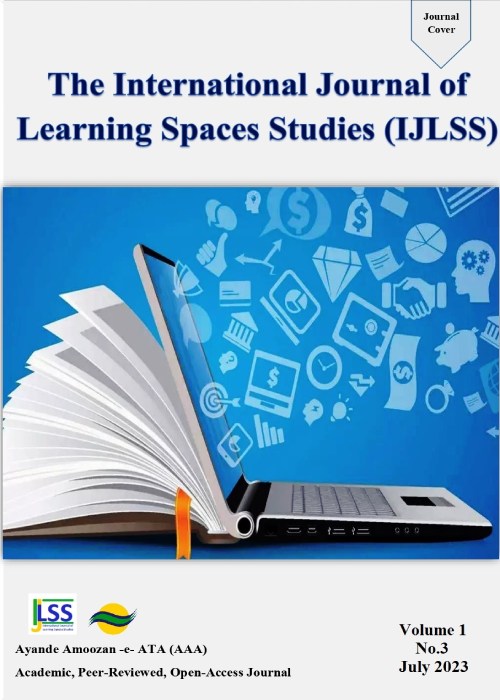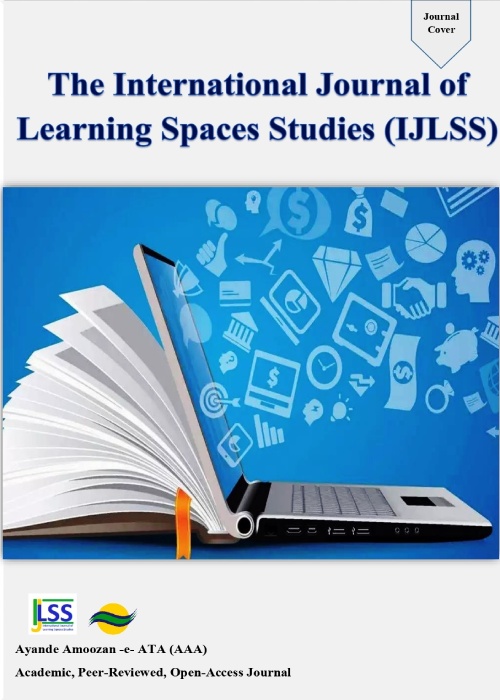فهرست مطالب

International Journal of Learning Spaces Studies
Volume:2 Issue: 2, Spring 2023
- تاریخ انتشار: 1402/06/06
- تعداد عناوین: 6
-
Pages 1-12PurposeThe research has studied the mediating role of information technology educational strategy and business strategy in information technology management on the performance of knowledge-based companies.MethodThe statistical population includes 5643 experts and managers of the Ports and Maritime Organization; The research sample was determined 360 according to Cochran's formula through simple random and stratified. A standard questionnaire and the structural equation modeling technique were used to collect and analyze data using SPSS and SMRATPLS statistical software.FindingsInformation technology management has a positive and significant effect on the educational strategy of information technology. The educational strategy of information technology has a positive and significant effect on the performance of the company. Information technology strategy has a positive and meaningful mediating role in the relationship between information technology management and company performance. Business strategy is related to business applications and should be aligned with business strategy. Business strategy has a positive and significant mediating role in relation to information technology management and company performance. Information technology management has a positive and significant effect on company performance.ConclusionAdopting Information technology management practices brings the company closer to aligning Information technology and business goals, which in turn improves company performance. Higher levels of Information technology management sophistication ensure an appropriate level of fit between Information technology and business strategies, which then leads to the appropriate selection and use of Information technology resources.Keywords: Information Technology Educational Strategy, Business strategy, Information technology management, Knowledge-Based Companies Performance
-
Pages 13-20PurposeThis research aims to identify the factors affecting the entrepreneurial ecosystem model in the university. In recent years, attention to entrepreneurship has increased in addition to educational and research missions in universities and scientific centers around the world.MethodThis mixed research is a survey that used the library method to identify the factors affecting the entrepreneurial ecosystem of the university, and in the next step, the influence of these factors has been investigated using the regression method. The studied population was experts of Azad University. Because the exact statistics of the statistical population were not available, the number of 384 people (emphasizing the adequacy of the Cochran sample size formula) was considered. SPSS version 25 statistical software was used for data analysis. In the quantitative part, a researcher-made questionnaire was used to collect data.FindingsBased on the investigations, 11 effective components were identified and evaluated. Structural factors, government factors, opportunity recognition, content factors, financial factors, economic factors, development and transfer of entrepreneurship, technological entrepreneurship, environmental factors, managerial factors, educational factors, cultural factors, scientific and technological factors, government factors, and leadership factors. Based on the regression method, all factors were confirmed.ConclusionThe findings of the present research show the fact that academic entrepreneurship is faced with a complex set of different components that creates its ecosystem. So that each of the dimensions of this sphere is woven into the internal components of the university and the higher education system, as well as the external components and subsystems of society.Keywords: entrepreneurial ecosystem, Knowledge-based entrepreneurship, Entrepreneurial University
-
Pages 21-34PurposeThe purpose of the present study was to provide a model of Engaging leadership using a qualitative meta-synthesis approach.MethodThe present research was conducted using the meta-synthesis method; Therefore, in the first step, 50 sources were obtained through a comprehensive search of sources, from which 27 articles related to the qualitative research method were selected in a 3-step refinement; And the concepts were extracted from the articles and by rereading the concepts, the categories were extracted from them and finally 10 dimensions and 70 categories were extracted and the final model was compiled.FindingsBased on the findings, inspiring leadership is based on ten dimensions: employee attitude, well-being at work, employee performance, strengthening commitment, continuous development of educational skills, engaging job and participation, spiritual support, engaging work environment, and satisfying psychological needs.ConclusionThe results show that Engaging leaders meet the needs of their followers in this way for communication; finally, by inspiring employees, engaging leaders acknowledge their personal contribution to the overall goal of the team or organization. Engaging leadership, due to its unique capabilities in creating conflict and people's enthusiasm at work, as an emerging concept, can increase the ability to face the challenges of companies. Knowledge-based to be effective.Keywords: Learn Engaging leadership, Exciting Leadership, Knowledge-Based Company, Learning Organization
-
Pages 35-44Purpose
Acquiring knowledge and using it effectively based on education is the only way to gain a competitive advantage and productivity in today's market. This research has focused on modeling training-oriented human resource management in voluntary organizations.
MethodThe research method is quantitative. The community of experts was Imam Khomeini's committee, based on Cochran's formula, 148 people were identified as a sample. At first, the validity of the questionnaire was checked using CVR and CVI indices. The questionnaire was given to 10 experts. The CVR value was 0.88 and the CVI value was 0.81. Based on the acceptable limit, both content validity indices were confirmed. The reliability of the questionnaire was obtained based on Cronbach's alpha index of 0.92, which was approved. The questionnaire was distributed among the sample members and the analysis was done by the confirmatory factor analysis method in AMOS software.
FindingsThe 8 dimensions identified in the theme analysis are supply, growth and training, motivation, maintenance, human resource infrastructure, consequences, internal environment, and external environment. The obtained results indicate that the creation of a suitable structure and organization of human resources causes the employees to move towards their main specialties and consequently increases the productivity of the organization.
ConclusionThe results of the quantitative section showed that all dimensions and components of the proposed research model were confirmed.
Keywords: Knowledge-oriented human resources, Learned Organization, Human resources training, Voluntary Organizations -
Pages 45-58PurposeThis research aims to identify the effective factors of the educational model of electronic supply chain management in order to achieve a world-class home appliance industry with a fuzzy approach.MethodsThis research is carried out through library and survey method based on the basic purpose. The library and the fuzzy Delphi methods were used to identify the factors and screen the identified codes in MATLAB software.FindingsThree rounds of Delphi were conducted. Based on the final results, 39 indicators were approved. Electronic procurement, customer relationship management, demand management, product development, logistics, electronics, quality and accuracy, information transactions, information up-to-date, transparency, information processing speed, security, software facilities, integration, stability, the cost compared to competitors, and expenses. Relative research and development, the percentage reduction in transfers, the satisfaction of supply chain members, percentage compatibility with goals, percentage supplier reduction, delivery time, order fulfillment time, distance traveled, percentage access to materials, relative ability to change production volume, size Order categories, electronic data exchange, Internet of Things, precautionary storage, strengthening the spirit of self-sacrifice among human resources, commitment, honesty, waiting time, customer service, flexibility, price, delivery speed, and responsiveness.ConclusionDue to the serious presence of foreign competitors in the home appliance market of Iran, the competitive position of domestic companies is in unfavorable conditions and it is necessary to design a suitable strategy for a flexible production.Keywords: Educational Model, Electronic Supply Chain Management, World Class Approach, Fuzzy Delphi
-
Pages 59-69Purpose
This research aims to identify the position of e-commerce at the gold and jewelry industry in Iran.
MethodRelated articles were reviewed in this field. Based on the CASP method, 8 articles were selected. Based on the meta-synthesis technique and using ATLAS TI software, related codes were extracted.
FindingsBased on the obtained results, 12 main categories and 79 primary codes were identified. These 12 categories are e-commerce services, technical systems, buying and selling systems, ethical and legal issues, consumer situations, seller situations, information accuracy, business management, support for online business systems, individual characteristics, system issues, and Human cases.
ConclusionBased on market pressure and technology development, like any other business, the gold and jewelry industry is also forced to use and develop e-commerce. The gold and jewelry industry plays an important role in Iran's economy. The e-commerce industry is one of the fastest-growing sectors in Iran, and online jewelry has also opened its way in this direction. The evidence points to the industry's slow pace in the rapid e-commerce trend. This lack of coordination of e-commerce adaptation with the structure of the gold and jewelry industry, especially in Iran, requires solving the problems and creating the necessary infrastructure.
Keywords: e-commerce, technology adoption, Gold, Jewelry Industry of Iran


